Virtual Science Museum
Lamps
An incandescent lamp uses a conductive filament, through which an
electric current is passed to heat it. The filament is contained inside
glass air tight envelope, which is either evacuated or filled with an
inert gas. The filament has to be heated to over 1000C to emit
white light. If this were done in air, the filament would oxidize and
burn out. An inert gas filling tends to be preferable to vacuum as it helps
to prevent the filament from evaporating. The gas has to be at low pressure
though, because otherwise it would conduct heat away from the filament,
making the lamp very inefficient and the glass envelope very hot. In the
early days, carbon used to be used for the filament. Carbon filaments
were replaced with tungsten for greater reliability. Modern lamps usually
use a coiled coil construction. A typical 15W lamp contains 750mm of
tungsten wire. Modern mains powered lamps usually have built-in fuses.
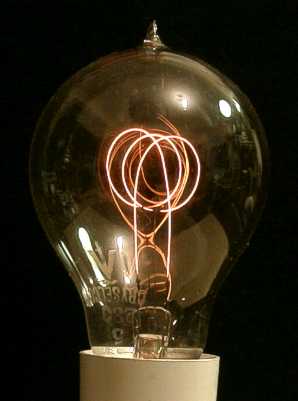 This carbon filament lamp is rated at 230V 5W and is made by Cryselco.
Carbon filaments were used in the first practical incandescent lamps.
Tungsten filaments replaced carbon in 1907, making this lamp over 97
years old. The filament is 3450 ohms when cold.
This carbon filament lamp is rated at 230V 5W and is made by Cryselco.
Carbon filaments were used in the first practical incandescent lamps.
Tungsten filaments replaced carbon in 1907, making this lamp over 97
years old. The filament is 3450 ohms when cold.
In the photograph it is being powered from 110Vdc. I found that powering
it from ac caused the filament to vibrate, presumably due to the magnetic
field. The filament has just three turns, but is so thin that it has
four support wires, two of which supply the current.
Note that the pump seal is at the top instead of inside the base. Despite
its age it has a standard bayonet base.
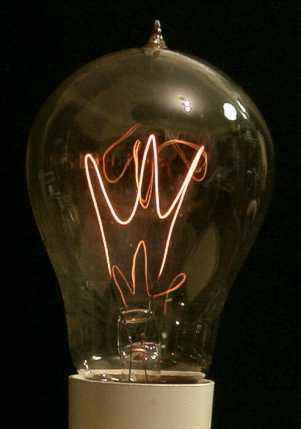 This carbon filament lamp is rated at 110V 16W and was made by Robertson.
The filament is 400 ohms when cold.
This carbon filament lamp is rated at 110V 16W and was made by Robertson.
The filament is 400 ohms when cold.
In the photograph, it is being powered from 40Vac. The filament has just
three turns and is unsupported except at the ends.
The base has a standard bayonet fitting.
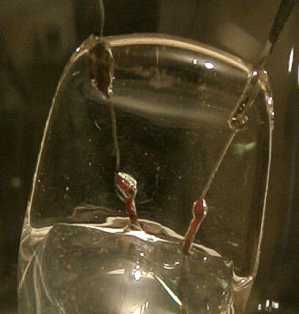 This is a close-up of the glass to metal seals in the stem of the Robertson
carbon filament lamp. It is interesting because of the materials used.
This is a close-up of the glass to metal seals in the stem of the Robertson
carbon filament lamp. It is interesting because of the materials used.
The wire has to have a co-efficient of expansion which matches the glass.
Modern lamps use a special composite wire called Dumet. It is very easy
to identify because it has a characteristic red appearance. These lamps
pre-date the Dumet seal and therefore use platinum wire.
Platinum has an expansion co-efficient which is a good match to soda-lime
glass. It is also resistant to oxidation and glass adheres well to it.
The main disadvantage is the high cost of platinum. It is for this reason
that the Dumet seal was developed.
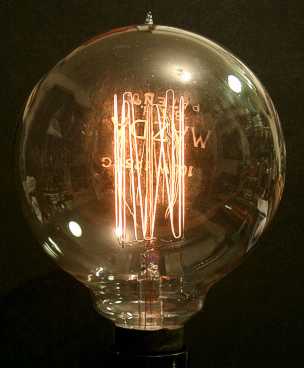 This is a very early tungsten filament lamp made by Mazda. The seal is at
the top of the lamp. It pre-dates the coiled coil filament, which is why
the filament has had to be strung up and down between 13 supports. The
bulb of the lamp is 115mm in diameter.
This is a very early tungsten filament lamp made by Mazda. The seal is at
the top of the lamp. It pre-dates the coiled coil filament, which is why
the filament has had to be strung up and down between 13 supports. The
bulb of the lamp is 115mm in diameter.
The lamp is rated at 125V 100W. In the photograph it is being powered from
just 30Vac.
The base has an Edison Screw fitting. The base is made of brass and I had to
clean off a thick layer of oxide before the lamp would light.
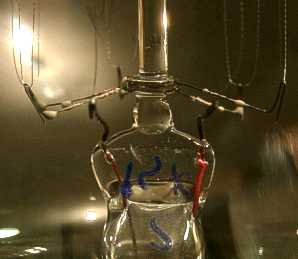 This is a close-up of the glass to metal seals and lower filament supports
of the Mazda lamp. Dumet seals appear to have been used. It is a fantastic
piece of glass work.
This is a close-up of the glass to metal seals and lower filament supports
of the Mazda lamp. Dumet seals appear to have been used. It is a fantastic
piece of glass work.
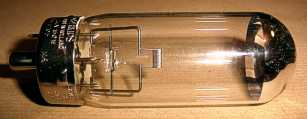 Philips 6289C/05 Projector lamp. The rating is 150W at 24V. It has a G17q7
Tru-Focus 4 pin base. Light output is 4350 lumens at rated power. This
lamp is 99mm long including the base. Low voltage operation makes the filament
more compact so that it behaves more like a point source.
Philips 6289C/05 Projector lamp. The rating is 150W at 24V. It has a G17q7
Tru-Focus 4 pin base. Light output is 4350 lumens at rated power. This
lamp is 99mm long including the base. Low voltage operation makes the filament
more compact so that it behaves more like a point source.
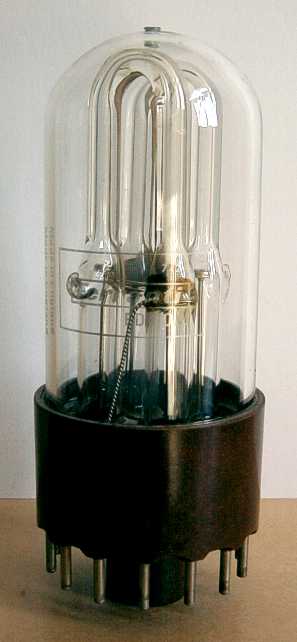 Ferranti EDN10 Xenon flash lamp. The outer envelope is just for protection and is
not air tight. The lamp actually contains two completely separate 'U' shaped flash
tubes. It is 125mm tall including the base and appears to be designed to operate
at high energy.
Ferranti EDN10 Xenon flash lamp. The outer envelope is just for protection and is
not air tight. The lamp actually contains two completely separate 'U' shaped flash
tubes. It is 125mm tall including the base and appears to be designed to operate
at high energy.
I have worked out the pin connections. They are as follows:
Pin 1 - Tube 1 Anode.
Pin 3 - Tube 1 Trigger.
Pin 5 - Tube 1 Cathode.
Pin 8 - Tube 2 Anode.
Pin 10 - Tube 2 Trigger.
Pin 12 - Tube 2 Cathode.
The other pins are unconnected.
I have tried operating it from a 100uF capacitor charged to 350V, connected from
anode to cathode. Connection of 4kV between trigger and cathode fires the lamp.
The flash is quite bright, but this is only 6J and I am sure that it is capable
of much more.
I don't have any specifications for this lamp. If you have any further
information, please email me.
There is more information about filament lamps in the
Glass Blowing section.
 This carbon filament lamp is rated at 230V 5W and is made by Cryselco.
Carbon filaments were used in the first practical incandescent lamps.
Tungsten filaments replaced carbon in 1907, making this lamp over 97
years old. The filament is 3450 ohms when cold.
This carbon filament lamp is rated at 230V 5W and is made by Cryselco.
Carbon filaments were used in the first practical incandescent lamps.
Tungsten filaments replaced carbon in 1907, making this lamp over 97
years old. The filament is 3450 ohms when cold. This carbon filament lamp is rated at 110V 16W and was made by Robertson.
The filament is 400 ohms when cold.
This carbon filament lamp is rated at 110V 16W and was made by Robertson.
The filament is 400 ohms when cold. This is a close-up of the glass to metal seals in the stem of the Robertson
carbon filament lamp. It is interesting because of the materials used.
This is a close-up of the glass to metal seals in the stem of the Robertson
carbon filament lamp. It is interesting because of the materials used. This is a very early tungsten filament lamp made by Mazda. The seal is at
the top of the lamp. It pre-dates the coiled coil filament, which is why
the filament has had to be strung up and down between 13 supports. The
bulb of the lamp is 115mm in diameter.
This is a very early tungsten filament lamp made by Mazda. The seal is at
the top of the lamp. It pre-dates the coiled coil filament, which is why
the filament has had to be strung up and down between 13 supports. The
bulb of the lamp is 115mm in diameter. This is a close-up of the glass to metal seals and lower filament supports
of the Mazda lamp. Dumet seals appear to have been used. It is a fantastic
piece of glass work.
This is a close-up of the glass to metal seals and lower filament supports
of the Mazda lamp. Dumet seals appear to have been used. It is a fantastic
piece of glass work. Philips 6289C/05 Projector lamp. The rating is 150W at 24V. It has a G17q7
Tru-Focus 4 pin base. Light output is 4350 lumens at rated power. This
lamp is 99mm long including the base. Low voltage operation makes the filament
more compact so that it behaves more like a point source.
Philips 6289C/05 Projector lamp. The rating is 150W at 24V. It has a G17q7
Tru-Focus 4 pin base. Light output is 4350 lumens at rated power. This
lamp is 99mm long including the base. Low voltage operation makes the filament
more compact so that it behaves more like a point source. Ferranti EDN10 Xenon flash lamp. The outer envelope is just for protection and is
not air tight. The lamp actually contains two completely separate 'U' shaped flash
tubes. It is 125mm tall including the base and appears to be designed to operate
at high energy.
Ferranti EDN10 Xenon flash lamp. The outer envelope is just for protection and is
not air tight. The lamp actually contains two completely separate 'U' shaped flash
tubes. It is 125mm tall including the base and appears to be designed to operate
at high energy.